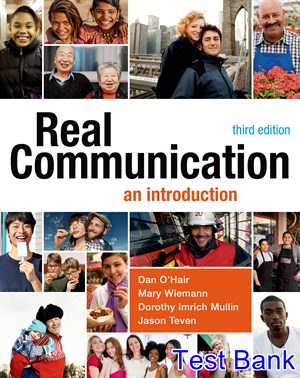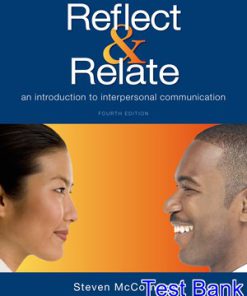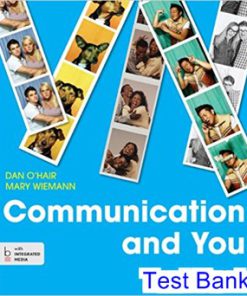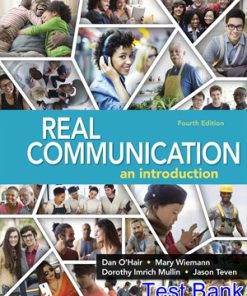Part One. Basic Communication Processes
Chapter 1. Communication: Essential Human Behavior
We Must Communicate: Functions Essential to Living
Expressing Affiliation
Managing Relationships
Influencing Others
How We Communicate
Communication Is Symbolic
Real Communicatior: Real communicator — what job will you hold?
Communication Requires a Shared Code
Communication Is Linked to Culture
Communication Can Be Unintentional
Communication Occurs through Various Channels
Communication Is Transactional
Assessing Communicative Value
Communicating Competently
Competent Communication is Process-Oriented
Competent Communication is Appropriate and Effective
Competent Communication Involves Ethical Decisions
Competent Communication Involves Communication Skills
Competent Communication Involves Using Technology
Wireless Communications: Email Etiquette: How
Not to Communicate with Your Professor
Modeling Communications
The Linear Model
The Interaction Model
The Competent Communication Model
Evaluating Communication Ethics: Friends Who Have More or Less than You
The Study of Communication
Communication Across Cultures: The Boko Haram Girls
REAL REFERENCE: A Study Tool
Chapter 2. Communicating in a Digital Age
Digital Origins
Then and Now
Ongoing Dynamic Changes
Qualities of Digital Channels
Evaluating Communication Ethics: The Distracted Notetaker
Synchronicity of Messages
Media Richness and Naturalness
Message Privacy and Control
Communication Across Cultures: Mobile Apps Compete for World Influence
Message Privacy and Control
The Power of the Crowd
Information Sharing
Social Support
Social Causes
Real Communicator: Heather Wight
Overcoming Digital Challenges
Digital Disparities
Feeding Insecurities and Obsessions
Wired for Communication: Who I Am: Selfies as Visual Conversation, Self-Promotion and Identity
Cyber Attacks
REAL REFERENCE: A Study Tool
Chapter 3. Perceiving the Self and Others
Perception: Making Sense of Your World
Schemas: Organizing Perceptions
Attributions: Interpreting Your Perceptions
The Cultural Context
Communication Across Cultures: Sports Culture and Women’s Soccer
Improving Your Perceptions
Cognitions About Ourselves
Self-Concept: Who You Think You Are
Self-Esteem: How You Feel About Yourself
Self-Efficiacy: Assesing Your Own Abilities
Evaluating Communication Ethics: Ethics and the Self-Concept
Assessing Our Perceptions of Self
Real Communicator: Lisa M. Turay, CSJ
Behavior: Managing Our Identities
Self-Presentation
Self-Disclosure
Managing Feedback
Technology: Managing the Self and Perceptions
Wired for Communication: Avatars: An Idealized Self-Image
REAL REFERENCE: A Study ToolChapter 4. Verbal Communication
The Nature of Language
Language Is Symbolic
Thought Informs Language
Language Is Ruled by Grammar
The Functions of Language
Using Language as a Means of Control
Using Language to Share Information
Using Language to Express Feelings
Using Language to Express Creativity
Using Language as Ritual
Language and Meaning
Words Have Multiple Meanings
Abstraction
Problematic Uses of Language
Hateful and Hurtful Language
Labeling
Biased Language
Profanity and Civility
Evaluating Communication Ethics: Job Application Language
Language is Bound by Context
Situational Context
Relational Context
Communication Across Cultures: Racist Hats and Drums?
Cultural Context
Wired for Communication: Speaking in Code
Real Communicator: Scott Carper
Mediated Contexts
REAL REFERENCE: A Study Tool
Chapter 5. Nonverbal Communication
The Nature of Nonverbal Communication
Nonverbal Behavior Is Communicative
Nonverbal Communication Can be Intentional and Unintentional
Nonverbal Communication Is Ambiguous
People Trust Nonverbal Communication More Than Verbal Communication
Functions of Nonverbal Communication
Reinforcing Verbal Messages
Substituting for Verbal Messages
Contradicting Verbal Messages
Managing Impressions and Regulating Interactions
Creating Immediacy
Deceiving Others
Nonverbal Communication Codes
Gestures and Body Movements
Real Communicator: Octavia Spencer
Facial Expressions
Eye Behavior
Voice
Physical Appearance
Evaluating Communication Ethics: The Job Killer Tat
Touch
Space and Environment
Time
Influences on Nonverbal Communication
Culture and Nonverbal Communication
Communication Across Cultures: What Nurses Wear
Mediated Nonverbal Communication
Wireless Communication: War Games Without Weapons, Sometimes Without Words
The Situational Context
REAL REFERENCE: A Study Tool
Chapter 6. Communication and Culture
Understanding Culture
Culture Is Learned
Culture Is Expressed Through Communication
Intercultural Communication Matters
Communication and Cultural Variations
High- and Low-Context Cultures
Real Communicator: Tanya Higuera
Collectivist and Individualist Orientations
Approaches to Power Distance
Flexible and Stable Self-Concepts
Time Orientation
Value of Emotional Expression
Understanding Group Affiliations
Co-Cultural Communication
Social Identity and Intergroup Communication
Wireless Communication: Online Gamers: Women are Hard-core, Too
Communication Across Cultures: The It Gets Better Project
Intercultural Communication Challenges
Anxiety
Ethnocentrism
Discrimination
Improving Intercultural Communication
Mindfulness
Openness to Other Cultures
Effective Intergroup Contact
Appropriate Accommodation
Evaluating Communication Ethics: That Is Not Impossible Meat
Practice Using Your Skills
REAL REFERENCE: A Study Tool
Chapter 7. Listening
The Listening Process
Hearing Versus Listening
The Components of Listening
Real Communicator: Tammy Lin
The Listening Process
Communication Across Cultures: A Quick Lesson in Deaf Etiquette
Listening Fidelity
Listening to Meet Goals
Relational Listening
Task-Oriented Listening
Analytical Listening
Critical Listening
Social Listening
Listening Challenges
Negative Attitudes
Environmental Factors
Biological Factors
Ineffective Listening
Defensive Listening
Biased Listening
Evaluating Communication Ethics: Listening When You’re Sick of Hearing
Self-Absorbed Listening
Pseudolistening
Improving Your Listening
The Situational Context
Wireless Communication: The Quiet Zone
Listening for Success
Effective Listening
Effective Listening Saves Time and Money
Effective Listening Creates Opportunities
Effective Listening Strengthens Relationships
REAL REFERENCE: A Study Tool
Part Two. Interpersonal Communication
Chapter 8. Developing and Maintaining Relationships
Types of Interpersonal Relationships
Family Relationships
Evaluating Communication Ethics: Money, Family, and Paying the Bills
Friendship and Social Relationships
Romantic Relationships
Online and Mediated Relationships
Wireless Communication: Is This Relationship Real?
Why We Form Relationships
Proximity
Attractive Qualities
Similarity
Personal and Social Needs
Managing Relationship Dynamics
Costs and Rewards
What About You? Assessing the Costs and Rewards of a Relationship
Reducing Uncertainty
Dialectical Tensions
Self-Disclosure and Interpersonal Relationships
Social Penetration
Managing Privacy
Strategic Topic Avoidance
Real Communicator: May Hui
Stages of a Relationship
Initiating Stage
Exploratory Stage
Intensification Stage
Stable Stage
Declining Stage
Repair Stage
Termination Stage
Communication Across Cultures: Grieving Relationships
Reconciliation
REAL REFERENCE: A Study Tool
Chapter 9. Managing Conflict in Relationships
Understanding Conflict
Unproductive Conflict
Productive Conflict
Conflict Triggers
Inaccurate Perceptions
Perceived Incompatible Goals
Relational Transgressions
Provocation
Factors Affecting Conflict
Power Dynamics
Attitudes Toward Conflict
Communication Climate
Culture and Conflict
Communication Channel
Wireless Communication: When Conflict Goes Viral
Strategies for Managing Conflict
Escapist Strategies
Competitive Strategies
Communication Across Cultures: Yours, Mine, and Both of Ours
Cooperative Strategies
Evaluating Communication Ethics: The Accidental Relationship Counselor
What About You? Self-Assessment on Conflict Management Styles
Reconciliation
Apology
Forgiveness
Real Communicator: Nicole Becker, Psy D.
REAL REFERENCE: A Study Tool
Part Three. Group and Organizational Communication
Chapter 10. Communicating in Groups
Understanding Groups
Characteristics of Groups
Types of Groups
Wirelessr Communication: Smart Mobs: What Flash Mobs and Political Protests Have in Common
Models of Group Development
Real Communicator: Bambi Francisco Roizen
Size of Groups
The Formation of Cliques
Social Loafing
Group Networks
Understanding Group Roles
Task Roles
Social Roles
Antigroup Roles
Role Conflict
Status
Group Climate
Cohesion
Communication Across Cultures: The International American Pastime
Norms
Clarity of Goals
Individual Differences
Evaluating Communication Ethics: Sketchy Behavior
REAL REFERENCE: A Study Tool
Chapter 11. Leadership and Decision Making in Groups
Understanding Group Leadership
Sources of Power
Shared Leadership
Group Leadership Behavior
Communication Across Cultures: Gender Judo
Leadership Qualities
What About You? What Type of Leader Are You?
Evaluating Communication Ethics: Leading the Interns
Unethical Leadership
Culture and Group Leadership
Decision Making in Groups
Groupthink
The Problem-Solving Process
Leadership in Meetings
Planning Meetings Effectively
Managing Meetings Effectively
Real Communicator: Aaron Tolson
Using Meeting Technology Effectively
Wireless Communication: Robots are here to stay
Evaluating Group Performance
Informational Considerations
Procedural Effectiveness
Interpersonal Performance
Individual Performance
REAL REFERENCE: A Study Tool
Chapter 12. Communicating in Organizations
Approaches to Managing Organizations
Classical Management Approach
Human Relations Approach
Human Resources Approach
The Systems Approach
Communicating Organizational Culture
Organizational Storytelling
Learning About Organizational Culture
Real Communicator: Cathy Black
Relational Contexts in Organizations
Supervisor-Supervisee Relationships
Mentor–Mentee Relationships
Peer Relationships
Evaluating Communication Ethics: More Than Friends at Work
Organizational Challenges
Workplace Conflict
Using Technology
Wired for Communication: Working Here, There, and Everywhere
Globalization
Communication Across Cultures: Work–Life Balance: Around the Globe and Around the Block
Work–Life Balance
REAL REFERENCE: A Study Tool
Part Four. Public Speaking
Chapter 13. Preparing and Researching Presentations
The Power of Public Speaking
Clarify the General Purpose of Your Speech
Informative Speeches
Persuasive Speeches
Special-Occasion Speeches
Analyze Your Audience
Considering Audience Expectations and Situational Factors
Considering Audience Demographics and Psychographics Anticipating Your Audience’s Response
Anticipating Your Audience’s Response
Choose Your Topic
Real Communicator: Matt Schermerhorn
Finding a Topic That Intrigues You
Brainstorming and Clustering
Narrowing Your Topic
Determining the Specific Purpose of Your Speech
Developing a Thesis Statement
Research the Topic
Types of Information to Consider
Communication Across Cultures: Human Trafficking: Art, Survival, and Advocacy
Finding Supporting Material
Wireless Communication: The Library in the Sky
Evaluating Supporting Material
Ethical Speaking: Take Responsibility for Your Speech
Recognizing Plagiarism
Evaluating Communication Ethics: Didn’t I Already Say That?
Taking Accurate Notes
REAL REFERENCE: A Study Tool
Chapter 14. Organizing, Writing and Outlining Presentations
Organizing Your Speech Points
Identifying Your Main Points
Supporting Your Main Points
Arranging Your Points
Evaluating Communication Ethics: The Ethics of Using Research
Connecting Your Points
Communication Across Cultures: Evidence, Popular Culture, and the “CSI Effect”
Using Language That Works
Respect Your Audience
Keep It Simple
Use Vivid Language
Incorporate Repetition, Allusion, and Comparisons
Crafting a Strong Introduction
Capture Your Audience’s Attention
Introduce Your Purpose and Thesis
Preview Your Main Points
Connect with Your Audience
Crafting a Strong Conclusion
Signal the End
Reinforce Your Topic, Purpose, and Main Points
Make an Impact
Real Communicator: Mark Weinfeld
Challenge the Audience to Respond
Outlining Your Speech
Essentials of Outlining
Wireless Communication: Bullets on the Brain
Styles of Outlines
From Preparation Outline to Speaking Outline
What About You? Assessing Your Outlining Skills
REAL REFERENCE: A Study Tool
Chapter 15. Delivering Presentations
Understand and Address Anxiety
Identify Anxiety Triggers
Relax and Prepare Mentally
Build Your Confidence
Wireless Communication: Face Your Public Speaking Fears in Virtual Reality
Methods of Delivery
Speaking from Manuscript
Speaking from Memory
Speaking Spontaneously
Speaking Extemporaneously
Guidelines for Effective Delivery
Effective Vocal Delivery
Effective Visual Delivery
Communication Across Cultures: You Sound Like You’re From . . .
Connecting with Your Audience
Evaluating Communication Ethics: Judging Speeches
Additional Guidelines for Online Speech Delivery
Real Communicator: Tonya Graves
Effective Presentation Aids
The Function of Presentation Aids
Types of Presentation Aids
Practicing Your Speech
Remember Your Speaking Outline
Practice Using Presentation Aids
Simulate the Situation
Practice Your Delivery
REAL REFERENCE: A Study Tool
Chapter 16. Informative Speaking
The Goals of Informative Speaking
Meeting the Audience’s Informational Needs
Informing, Not Persuading
Speaking Appropriately and Ethically
Topics for Informative Presentations
People
Places
Communication Across Cultures: Let’s Talk About Sex
Events
Evaluating Communication Ethics: Ulterior Motives
Processes
Concepts
Issues
Plans and Policies
Approaches to Conveying Information
Description
Demonstration
Wireless Communication: Talk Amongst Yourselves
Definition
Explanation
Guidelines for Informative Speeches
Create Information Hunger
Satisfy Audience Hunger
Real Communicator: K. C. Ellis
REAL REFERENCE: A Study Tool
Chapter 17. Persuasive Speaking
The Goals of Persuasive Speaking
Developing a Persuasive Topic and Thesis
Propositions of Fact
Propositions of Value
Propositions of Policy
Understanding Your Audience
Your Audience’s Existing Attitudes
Your Audience’s Readiness to Change
Your Audience’s Needs
Your Audience’s Motivation and Interest
Wireless Communication: Interactive Advertising: Persuasion for a Generation Z Audience
Strategies for Persuasive Speaking
Evaluating Communication Ethics: Sensitivity or Free Speech?
Logos
Communication Across Cultures: Persuading Across Borders
Pathos
Avoiding Logical Fallacies
Bandwagoning
Reduction to the Absurd
Red Herring
Personal Attack
Hasty Generalizations
Begging the Question
Either–or Fallacy
Appeal to Tradition
The Slippery Slope
The Naturalistic Fallacy
Real Communicator: Katie McGill
Organizing Patterns in Persuasive Speaking
Problem–Solution Pattern
Refutational Organizational Pattern
Comparative Advantage Pattern
Monroe’s Motivated Sequence
REAL REFERENCE: A Study Tool
Appendix A. Competent Interviewing
The Nature of Interviews
Types of Interviews
Information-Gathering Interviews
Persuasive Interviews
Selection Interviews
Performance Appraisal Interviews
Exit Interviews
Interview Format
The Opening
The Questions
Evaluating Communication Ethics: Surveys: Interviewing at Large
The Conclusion
Real Communicator: Cynthia Guadalupe Inda
Roles and Responsibilities in Interviews
Interviewer Responsibilities
Interviewee Responsibilities
Shared Responsibilities
The Job Interview
Communication Across Cultures: Cultural Competence in Social Work
Getting the Interview
Wireless Communication: Pre-Presenting Yourself: Your Online
Conducting the Interview
Following Up After the Interview
REAL REFERENCE: A Study Tool
Appendix B. Mass and Mediated Communication
The Nature of Mass Media
Types of Mass Communication
The Pervasiveness of Media
Understanding Mass Media Messages
The Business of Media
Wireless Communication: New Life Through Digital Media
Free Speech and Media Bias
Communication Across Cultures: The Sesame Effect
Effects of Mass Media
Selectivity and the Active Audience
Influences on Attitudes and Behaviors
Mass Communication in a Digital Age
Mass Self-Communication
Evaluating Communication Ethics: Marketing for a Better Band
Media Personalization
Ineffective Participation
Competent Media Consumers
Monitor Your Media Use and Exposure
Consider the Source of Media Messages
Be Aware of Media Effects
Understand the Grammar of Media
Real Communicator: Molly Ludwig
Actively Evaluate Media Messages
REAL REFERENCE: A Study Tool













